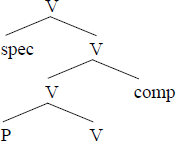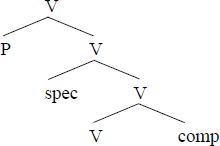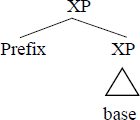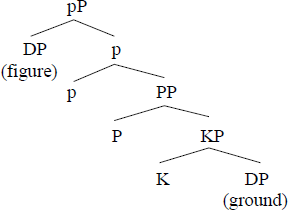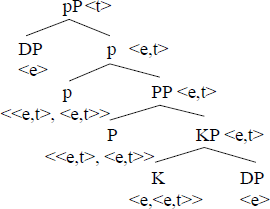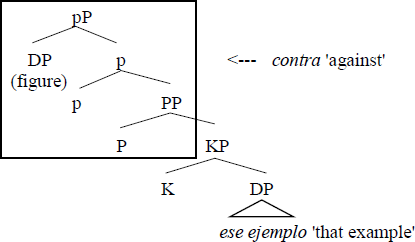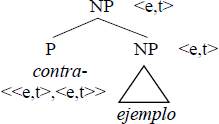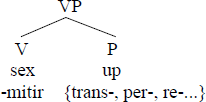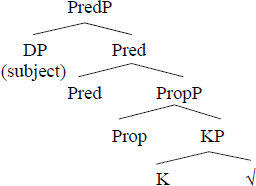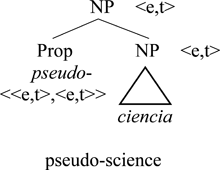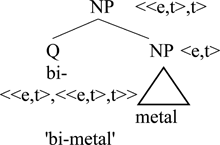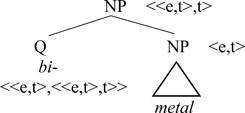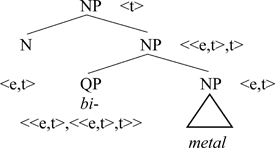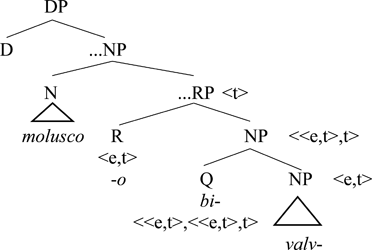1 The problem
My goal in this article is to show that there are three grammatically relevant subclasses of prefixes in Spanish, possibly also in other Romance languages. I label the three classes relational (1a), adjectival (1b) and quantifying (1c).
- (1)
- a.
- pre- ‘pre’, des- ‘un-’, sobre- ‘over-’
- b.
- pseudo- ‘pseudo’, maxi- ‘maxi-’, micro- ‘micro-’
- c.
- multi- ‘multi-’, in- ‘un-’, bi- ‘bi-’
I will show that the three subgroups differ in several empirical properties. I will argue that these properties are captured if the class in (1a) contains reduced prepositional structures; (1b), reduced adjectives and (1c), reduced nominal quantifiers. I analyse (1a) and (1b) as modifiers, and (1c) as operators. Table 1 summarises my proposal about the three classes.
Table 1: Three classes of prefixes.
| Type of prefix | Syntactic label | Syntactic configuration | Semantic type |
| Relational prefixes (1a) | Reduced prepositions | modifiers / adjuncts | <<e,t>,<e,t>> |
| Adjectival prefixes (1b) | Reduced adjectives | modifiers / adjuncts | <<e,t>,<e,t>> |
| Quantifier prefixes (1c) | Reduced nominal quantifiers | operators binding a variable | <<e,t>,<<e,t>,t>> |
While the framework where my analysis is couched is Nanosyntax (Starke 2009; Caha 2009), I have made an effort to present my analysis in more neutral terms. My analysis is formulated so that it is compatible with any system which meets the following three requirements: (i) it is a formal Generative Framework (Chomsky 1957; 1965) where features drive the computation (Chomsky 1981; 1995), (ii) it allows some form of type-theoretical semantics (Church 1940; Montague 1974) and (iii) it has no autonomous morphological component.
As is well-known, other criteria beyond the category of the item have been proposed to group prefixes into subclasses. The most popular of them in Romance languages, although it is pre-theoretical, is semantic. The most influential criterion to analytically differentiate between types of prefixation is their structural height, as in Di Sciullo’s (1997) influential approach. In contrast, while Di Sciullo (2005a) and Di Sciullo & Slabakova (2005) discuss natural classes of affixes given their feature endowment, to the best of my knowledge, a classification of prefixes based on the grammatical category that they instantiate has not been systematically attempted. However, a category-based distinction is implicitly assumed at least since Darmesterter’s (1875) proposal that left-linearised morphemes tend to be prepositions or adverbs. This issue has also been part of the discussion about the limits between compounding and prefixation (Rainer & Varela 1992; Marqueta Gracia 2018). This article identifies three distinct sets of empirical properties that, I will argue, reflect the grammatical category of each group of prefixes.
One of the reasons that linguists have felt the need to discuss subclassifications of prefixes is the well-known fact that ‘prefix’ is not a label that defines a natural class with a regular grammatical behaviour. ‘Prefix’ presupposes a positional definition that goes back to Akkadian texts (Black 2000): prefixes are affixes that attach to the left boundary of the base. This merely positional definition sharply contrasts with current grammatical practice, where the consensus is that linear position is not enough to identify the grammatically relevant natural classes. This linear definition groups a heterogeneous class of objects, including inflectional and derivational affixes (e.g., Bantu agreement prefixes) that sometimes seem to behave as heads (Gràcia & Azkarate 2000). My goal to identify the relevant grammatical classes of prefixes in Spanish stems from the concern that we still use terminology that does not group affixes into natural classes that can be useful as a starting point for a grammatical analysis.
The rest of this article is structured as follows: in the remainder of this section, I will introduce the main criteria to define subclasses of prefixes and show that the positional definition of prefix does not isolate a set of elements with the same grammatical behaviour. In §2, I will motivate a tripartite division among prefixes for Spanish, possibly extendable also to other Romance languages. In §3–§5, I will present my analysis: after explaining my assumptions in §3, I analyse the two classes of prefixes that act as modifiers in §4 and the class that acts as operators in §5. §6 closes the article.
1.1 Classifications of prefixes
Linguists have known for a long time that a positional definition of ‘prefix’ is insufficient, and as a result different attempts have been made to identify its subclasses. The most popular of these classifications in Romance languages uses as a criterion the semantic concept denoted by the prefix, which, however, does not identify grammatically relevant classes. Varela & Martín García (1999), for instance, differentiate between spatial, temporal, negative, degree, aspectual and modificational prefixes. RAE & ASALE (2009: §10.5–10.12) proposes eight semantic classes: spatial, temporal or aspectual, quantifying, degree, negation, oppositional and favourable attitude prefixes, prefixes with incidence in argument structure and adjectival prefixes.
This classification does not define grammatically relevant classes: the same prefix may fall into more than one group (cf. sobre-volar ‘over-fly’, which would be spatial, vs. sobre-valorar ‘over-estimate’, which would be degree-related). At the same time, members of each class may display different grammatical behaviours, as we will see in §2.
Another type of classification, this time with grammatical relevance, divides the prefixes depending on the structural height at which they are introduced (cf. Di Sciullo 1997; 2005b). While all prefixes are adjuncts, prepositional prefixes are low-attached, while adverbial prefixes are high-attached. The two classes contrast with respect to whether they affect, for instance, the argument structure of the base.
My theoretical goal in this article is to argue for a third type of classification that I would like to label ‘category-internal’: the grammatical category of each prefix, manifested both in the formal features that they contain and their semantic type. I will motivate the existence of three classes of prefixes in Spanish, and I will briefly show that, possibly, the same classes can be extended at least to other Romance languages. But before doing so, let me briefly remind the reader of why this type of classification is necessary.
1.2 Prefixes, even in one single language, do not have a homogeneous behaviour
The Spanish literature about prefixes (Varela 1990, Martín García 1998; Varela & Martín García 1999; Felíu 2003; Gibert Sotelo 2017; 2021) defines them, in opposition to suffixes, through a set of properties that have also been proposed in other Romance languages (Scalise 1983), namely:
-
a) Prefixes are iterable, that is, they can be added a second time to a word that already contains them (2).
- (2)
- a.
- contra-argumentar
- counter-argue
- ‘to argue against’
- b.
- contra-contra-argumentar
- counter-counter-argue
- ‘to reply to a counterargument’
b) Prefixes cannot change the grammatical category of the base. The result of prefixing a noun is still a noun (ejemplo ‘example’ > contra-ejemplo ‘counterexample’), the result of prefixing a verb is also a verb (decir ‘say’ > contra-decir ‘counter-say, refute’), and so on.
c) Prefixes act as modifiers of the base, incorporating to it different notions –spatial, temporal, negative, degree…– in the same way as adjuncts do in syntax (see Di Sciullo 1997; 2005b), in contrast to suffixes that can introduce selectional restrictions on their projections, (Di Sciullo 1995).
However, it is easy to find prefixes that do not comply to any of these properties. The negative prefix in- is such an example. The prefix in- cannot be iterated, even when constituent negation can in fact combine with it (3).
- (3)
- a.
- in-útil
- un-useful
- ‘useless’
- b.
- *in-in-útil
- un-un-useful
- Intended: ‘not useless’
The prefix in- can turn a noun into an adjective: in cases like (4), we have nouns that combine with determiners and carry no agreement, while in (5) we have clear cases of adjectives that agree in gender and number with the corresponding noun. At least superficially, the prefix is the only derivational affix added (see below, §2.4, for why a parasynthetic analysis with a zero suffix is untenable).
- (4)
- a.
- color ‘colour’, dolor ‘pain’
- b.
- *vacuna {color-a / dolor-a}
- vaccine {colour-f / pain-f}
- Intended: ‘coloured vaccine, painful vaccine’
- (5)
- a.
- in-color-o, in-dolor-o
- un-colour-m, un-pain-m
- b.
- vacuna {in-color-a / in-dolor-a}
- vaccine un-colour-f / un-pain-f
- ‘colourless vaccine, painless vaccine’
Finally, it is very unlikely that negation involves modification or adjunction. At the very least, negation licenses Negative Polarity Items (NPIs, see Horn 1989), which must be c-commanded by it, which is at odds with the general view of adjuncts as semantically and syntactically independent from the rest of the clausal material.
Given this situation, we must accept that ‘prefix’ does not define a homogeneous class of grammatical objects. In addition to anything we can learn from their syntactic position, we need a classification that truly addresses their grammatical behaviour and identifies the types of entities that fall within this blanket term. In the next section I will argue that in Spanish the blanket term ‘prefix’ contains at least three subclasses of grammatically distinct objects.
2. Three grammatically relevant classes of prefixes
In this section, I will argue that the affixes that linearise to the left of the base in Spanish fall into three groups according to their grammatical properties: relational prefixes (6), adjectival prefixes (7) and quantifier prefixes (8). (6)–(8) shows some of the most common prefixes in each class (see Fábregas 2023 for a more exhaustive list).
- (6)
- a-, ab-, ad-, ana-, anfi-, ante-, anti-, apo-, arce-, archi-, arqui-, auto-, bien-, circun-, co-, con-, contra-, de-, dentro-, des-, en-, entre-, equi-, ex-(separative), extra-, in-(directional), infra-, inter-, intra-, intro-, medio-, menos-, ob-, per-, peri-, plus-, por-, post-, pre-, preter-, pro-, pro-, puto-, re-, requete-, retro-, sin-, so-, sobre-, son-, sub-, super-, supra-, suso-, tatara-, tele-, trans-, ultra-, yuxta-
- (7)
- acro-, alo-, braqui-, cis-, citra-, cuasi-, demi-, dipso-, eco-, ecto-, endo-, epi-, eu-, ex- (temporal), exo-, hemi-, hemo-, hetero-, hipo-, holo-, homeo-, homo-, iso-, macro-, maxi-, meso-, meta-, mini-, nano-, neo-, omni-, orto-, paleo-, pan-, para-, pen-, piro-, proct-, proto-, pseudo-, quiro-, semi-, sud-, tatara-, vice-, xeno-, xero-, xilo-
- (8)
- a-(negative), ambi-, anfi-, bi-, bis-, bronto-, centi-, cuatri-, deca-, deci-, diali-, dodeca-, endeca-, enea-, exa-, femto-, giga-, hecto-, hella-, hexa-, icosa-, in-(negative), kilo-, mega-, micro-, mili-, mono-, multi-, no-, octo-, pebi-, penta-, pico-, pluri-, poli-, quecca-, quecto-, quetta-, recien-, ronna-, ronto-, satis-, sesqui-, sex-, tera-, tetra-, todo-, uni-, xenna-, yocto-, yotta-, zepto-, zetta-
I will call the class in (6) ‘relational prefixes’. As we will see, they have properties of prepositional modifiers, and are related to the syntactic structure of prepositions (following intuitions that go back to Darmesteter 1875).1 Adjectival prefixes –terminology that I take from RAE & ASALE (2009)– in (7) are those prefixes that behave as adjectival modifiers. Prefixes in (8) act as quantifiers that take a constituent within the base as its variable. Therefore, I call them ‘quantifier prefixes’. Most (but not all, cf. des-) prefixes classified as negative fall in this class, as negation is also an operator.
Seven tests motivate my proposal to differentiate between these three groups. I will illustrate them for Spanish, showing also parallels in Italian, French and Portuguese.2
2.1 Combination with lexical categories
The claim that ‘prototypical’ prefixes can combine with any lexical category should be restricted to the class in (6), relational prefixes. For instance, the place prefix sub- combines with lexical categories of the three main classes: nouns, qualifying adjectives and verbs.
- (9)
- a.
- sub-campeón
- sub-champion
- ‘finalist’
- b.
- sub-normal
- sub-normal
- ‘retarded’
- c.
- sub-estimar
- sub-estimate
- ‘underestimate’
See also Portuguese sub-campeão, subnormal, subestimar (Rio-Torto et al. 2013: 339 et folls.); Italian sotto-titolo ‘undertext’, sotto-marino ‘sub-marine’, sotto-valutare ‘underestimate’ (Grossmann & Rainer 2004: 111–113); French sous-chef ‘second chef’, sous-cutané ‘subcutaneous’, sous-estimer ‘undervalue’ (see Amiot 2008 for other prefixes with these properties in French). There is a core semantics that is common: the notion of being below some reference point. In (9a) this inferiority is defined as a subordination to a champion; in (9b) the inferiority is interpreted as involving the values below a scale of ‘normality’, and in (9c) the inferiority is interpreted as a lack of appreciation, that locates an entity below the value that it should have.
This contrasts with prefixes expressing location but belonging to the set in (7), which I call ‘adjectival prefixes’. Consider the prefix hipo-, whose semantics is also one of (spatial) inferiority. Here, the prefix must combine with nouns or relational adjectives.
- (10)
- a.
- hipo-centro
- hipo-center
- (Port. hipocentro, It. ipocentro, Fr. hypocentre)
- b.
- hipo-calórico
- hipo-caloric
- (Port. hipocalórico, It. ipocalorico, Fr. hypocalorique)
- c.
- *hipo-normal
- hipo-normal
- (Port. *hiponormal, It. *iponormale, Fr. *hyponormale)
- d.
- *hipo-estimar
- hipo-estimate
- (Port. *hipoestimar, It. *ipovalutare, Fr. *hypoestimer)
Hipo- and the rest of the adjectival prefixes (7) only combine with nouns and relational adjectives. Remember that relational adjectives such as ‘caloric’ have been argued to be covert nouns (Bosque 1993; Fábregas 2020), in contrast to qualifying adjectives. A relational adjective can also modify another relational adjective, as in (33; cf. Bosque 1993):
- (11)
- literatura
- literature
- [medieval
- medieval
- [francesa]]
- French
- ‘French medieval literature’
Let me compare quantifier prefixes with the previous two subclasses through the prefix mono-. Like the prefixes in (7), quantifier prefixes are productive with nouns and relational adjectives, but not with verbs or qualifying adjectives.
- (12)
- a.
- mono-cultivo
- mono-culture
- (Port. monocultivo, It. monocultivazione, Fr. monoculture)
- b.
- mono-camer-al
- mono-chamber-adj
- (Port. monocameral, It. monocamerale, Fr. monocaméral)
- ‘with only one (legislative) organ’
- c.
- *mono-difícil
- mono-difficult
- (Port. *monodifícil, It. *monodifficile, Fr. *monodifficile)
- d.
- *mono-obsesionar
- mono-obsess
- (Port. *mono(o)bsessar, It. *monoossesionare, Fr. *monoobséder)
Again, conceptual semantics does not explain (12c, 12d): we could say that something is only difficult in one sense, and we could say that one has a single obsession, but still these forms are ungrammatical. The selection of category, in contrast, is expected if these prefixes are quantifiers that are looking for individual or kind variables, just like uno ‘one’, dos ‘two’, tres ‘three’, which only combine with nouns.
- (13)
- a.
- dos chicos
- two boys
- b.
- *dos difícil
- two difficult
- c.
- *dos obsesionar
- two to.obsess
2.2 Iteration
A standard claim is also that prefixes differ from suffixes in allowing iteration. However, only a small set of prefixes can iterate. Consider first the class of relational prefixes, for instance sobre-. Clearly, sobre- can iterate.
- (14)
- sobre-sobre-explotar
- over-over-exploit
Once we define an event as excessive, we can emphasise the excessiveness by repeating the same prefix, sobre-, with the meaning that one is exploiting something way beyond what it is advisable. The same goes for the use that signals a high degree of the property denoted by the qualifying adjective.
- (15)
- sobre-sobre-barato
- over-over-cheap
With nouns, the same is possible: if we take a noun like (16) we can build a prefixed noun that refers to an entity that is above the coat.
- (16)
- sobre-abrigo
- over-coat
If we now want to refer to another piece of clothing that puts over the overcoat, we can express this through a repetition of the prefix:
- (17)
- sobre-sobre-abrigo
- over-over-coat
See also Italian ri ri-cominciare ‘to restart again’ (Scalise 1983), Portuguese super-super-explorar ‘over-over-exploit’, French après-après-guerre ‘post-post-war’. All prefixes in (6) can in principle iterate, and the only restriction is semantic: when the prefixes denote some type of notion that does not produce a distinct result when iterated, as in the case of trans- ‘through’, or auto- ‘self’, iteration is not documented. For this reason, iteration is particularly easy with prefixes denoting opposition, such as anti-, contra- ‘counter-’, and not so much with those denoting a favourable attitude, as in pro- ‘in favour of’. The point is that there is nothing formal in the grammar of these prefixes that blocks iteration.
Let us now move to adjectival prefixes (7), which can also iterate. Consider pseudo-. A noun like ciencia can be prefixed with pseudo- to express that the referent only seems to be science (18).
- (18)
- pseudo-ciencia
- pseudo-science
If we now wish to refer to an entity as something that looks like pseudo-science but it is actually not, we can repeat the prefix again.
- (19)
- pseudo-pseudo-ciencia
- pseudo-pseudo-science
- (Port. pseudopseudociência, It. pseudopseudoscienza, Fr. pseudopseudoscience)
Adjectival prefixes can in principle be iterated, but sometimes the notion they express does not trigger new readings by iteration, as it is the case of iso- ‘similar’, or pan- ‘complete’. In contrast, prefixes that denote notions whose iteration produces a difference in meaning, like mini- or semi-, can easily be iterated: mini-mini-libro ‘mini-mini-book’, or semi-círculo ‘half circle’ > semi-semi-círculo ‘a quarter of a circle’.
Finally, quantifier prefixes in (8) can never be iterated. Take bi- ‘bi-’ and imagine we talk about any entity that has two colours; we can refer to that entity with the prefixed structure including bi-:
- (20)
- banderas
- flags
- bi-color-es
- bi-colour-pl
- ‘flags with two colours’
However, we cannot build (21a) for a flag has four colours. Similarly, if we want to say that some entity has 12 or 20 colours, (21b) and (21c) are still ungrammatical.3
- (21)
- a.
- *banderas
- flags
- bi-bi-color-es
- bi-bi-colour-pl
- b.
- *banderas
- flags
- deca-bi-color-es
- deca-bi-colour-pl
- c.
- *banderas
- flags
- bi-deca-color-es
- bi-deca-colour-pl
See also It. *(bandieri) bi-bi-colori, Port. *(bandeiras) bi-bi-color, Fr. *(drapeaux) bi-bi-colores. Thus, with respect to this test we have a division between two groups: prefixes in (6) and (7) can be iterated, while prefixes in (8) class cannot.
2.3 Combinations within the class
While it is impossible to combine two quantifier prefixes, two or more relational or adjectival prefixes can be combined. We can combine pro- and anti-, for instance to express the property of being against those that are in favour of racism (22), or combine two adjectival prefixes, as in (23).
- (22)
- anti-pro-racismo
- anti-pro-racism
- (Port. anti-pró-racismo, It. anti-pro-razzismo, Fr. anti-pro-racisme)
- (23)
- pseudo-pan-teísmo
- pseudo-pan-theism
- (Port. pseudopanteísmo, It. pseudopanteismo, Fr. pseudopantheisme)
2.4 Category change
The claim that prefixes never alter the grammatical category of the base is falsified by quantifier prefixes, which systematically can turn nouns into adjectives with number and gender agreement. Consider for instance the noun in (24a), which cannot be used as an adjective, as shown in (24b). Once we combine it with the quantificational negative prefix a-, the noun becomes an agreeing adjective.
- (24)
- a.
- sépalo
- sepal
- b.
- *flores
- flowers
- sépal-a-s
- sepal-f-pl
- c.
- flores
- flowers
- a-sépal-a-s
- a-sepal-f-pl
- ‘flowers without sepals’
This is a general property of quantifier prefixes, most of which trigger this N > A category change.
- (25)
- a.
- uniformes
- uniforms
- *(tetra-)color-es
- tetra-colour-pl
- ‘uniforms with four colours’
- b.
- plantas
- plants
- *(multi-)flor-a-s
- multi-flower-f-pl
- ‘plants with lots of flowers’
- c.
- sistemas
- systems
- *(pluri-)partid-o-s
- pluri-party-m-pl
- ‘systems with lots of political parties’
- d.
- animales
- animals
- *(bi-)valv-o-s
- bi-valve-m-pl
- ‘animals with two valves’
- e.
- palabras
- words
- *(poli-)sílab-a-s
- poly-syllable-f-pl
- ‘words with several syllables’
See also Portuguese (animais) bivalves, Italian (animali) bivalvi, French (animaux) bivalves. Languages also differ in individual cases; Spanish polisílabo and Portuguese polissílabo, without overt adjectivaliser, contrast with French and Italian, where polisillabique / polisillabico, with the adjectivaliser -ique / -ico, are preferred.
Adjectival or relational prefixes, in contrast, cannot turn a nominal base into an agreeing noun. An anonymous reviewer asks why the cases above cannot be treated as parasynthesis. Let me show why this would not work with a comparison with relational prefixes, which can participate in verbal parasynthesis (26).
- (26)
- a.
- en-carcel-a
- in-prison-ThV
- ‘to imprison’
- b.
- a-clar-a
- to-clear-ThV
- ‘to clear’
It is possible to show that in (26) the category change is related to a zero verbaliser, while the cases in (25) do not contain a zero adjectivaliser. Borer (2013) argues, for English, that there is no zero nominaliser based on the observation that verbs that contain overt verbal suffixes cannot be zero-converted into nouns, as in (27).
- (27)
- a.
- attack
- >
- an attack
- b.
- class-ify
- >
- *a classify
- c.
- atom-ise
- >
- *an atomise
If English had a zero nominaliser, (27b, 27c) should be possible: despite the overt presence of verbal structure –spelled out as the overt verbaliser–, the nominaliser should be able to turn the verb into a noun. As this is not possible, English cannot have a zero nominaliser and (27a) should be analysed as a root embedded under nominal functional projections (Num, D…), not a case of a nominalised verb. We can apply the same strategy to the cases in (25) and (26) to show that there is a zero verbaliser in Spanish, but not zero adjectivaliser.
With respect to a possible zero adjectivaliser, if there was one, we should expect it to be generally possible for Spanish to zero-derive adjectives from nouns that contain overt nominalisers, but this is not possible. Note that we use in (28) state and quality nouns not derived from adjectives, to favour that semantically it is easy to interpret them as gradable properties.
- (28)
- a.
- b.
- c.
- modera-ción
- modera-tion
- aburri-miento
- bore-dom
- cor-aje
- courage
- >
- >
- >
- *muy moderación
- very moderation
- *muy aburrimiento
- very boredom
- *muy coraje
- very courage
Thus, there is no zero adjectivaliser in Spanish. In contrast, there is a zero verbaliser: verbs can be zero-derived from nouns or adjectives that contain overt affixes:
- (29)
- a.
- b.
- c.
- d.
- erup-ción
- erup-tion
- influ-encia
- influ-ence
- orna-mento
- orna-ment
- olor-oso
- smell-y
- >
- >
- >
- >
- erup-cion-a
- erup-tion-ThV
- influ-enci-a
- influ-ence-ThV
- orna-ment-a
- orna-ment-ThV
- olor-os-a
- smell-y-ThV
Moreover, it would be arbitrary to invoke a zero adjectivaliser that can only be used together with a quantifier prefix; Spanish does not have other circumfixes, so these would be the only cases of that type of affix.
In conclusion: relational (and adjectival) prefixes never cause category change, as this is performed by a zero verbaliser; quantifier prefixes are associated to category change, as there is no zero adjectivaliser.
2.5 Licensing a noun as a modifier without category change
Relational adjectives can license the base as a noun modifier without category change. The best studied case of this involves the prefixes anti- and pro- (Martín García 2005). In (30) the noun cannot modify the head noun, but, once it contains a relational prefix, modification is licensed.
- (30)
- a.
- crema
- cream
- *(anti-)arrug-a-s
- anti-wrinkle-f-pl
- b.
- manifestaciones
- demonstrations
- *(pro-)abort-o
- pro-abortion-m
See also Portuguese creme *(anti-)rrugas, Italian crema *(anti-)rughe, French crème *(anti-)rides. Many other relational prefixes are documented with this property: just like prepositions, they turn the base noun into a modifier of another noun.
- (31)
- a.
- vestido
- dress
- *(pre-)mamá
- pre-mother
- ‘dress inteded for a pregnant woman’
- b.
- depresión
- depression
- *(post-)parto
- post-birth
- ‘depression that happens after giving birth’
- c.
- lema
- motto
- *(ante-)título
- before-title
- ‘motto that appears before a title’
- d.
- libro
- book
- *(super-)ventas
- super-sales
- ‘book that is sold above expectations’
- e.
- ronda
- round
- *(inter-)equipos
- between-teams
- ‘round where different teams compete with each other’
In contrast, this is not possible with adjectival prefixes.
2.6 Parasynthesis and berry verbs
Prefixes that appear in verbal or adjectival parasynthesis are always relational.
- (32)
- prisión ‘prison’
- página ‘page’
- flor ‘flower’
- vía ‘road’
- trono ‘throne’
- patria ‘motherland’
- vaso ‘recipient’
- comilla ‘bracket’
- signo ‘sign’
- hijo ‘son’
- tarde ‘late’
- tierra ‘earth’
- agua ‘water’
- raya ‘line’
- borda ‘gunwale’
- > a-prision-a ‘imprison’
- > com-pagin-a ‘combine’
- > contra-flor-ado ‘with flowers opposed to each other’
- > des-vi-a ‘deviate’
- > en-tron-iz-a ‘enthrone’
- > ex-patri-a ‘expatriate’
- > extra-vas-a ‘overflow’
- > entre-comill-a ‘put into brackets’
- > per-sign-a ‘cross’
- > pro-hij-a ‘adopt’
- > re-tard-a ‘delay’
- > so-terr-a ‘bury’
- > sobre-agu-a ‘walk over the water’
- > sub-ray-a ‘underline’
- > trans-bord-a ‘transfer’…
I am not aware of any case of parasynthesis involving quantifier or adjectival prefixes.
Also, relational prefixes are the only ones that can appear in so-called berry verbs. Since Aronoff (1976) it has been noted that some Latinate formatives cannot function as verbs unless combined with a prefix, as in (33–35).
- (33)
- -curr-
- con-curr-i ‘take part’, dis-curr-i ‘flow, think’, es-curr-i ‘drain’, in-curr-i ‘commit’, o-curr-i ‘happen’, re-curr-i ‘complain, use’, trans-curr-i ‘flow’
- (34)
- -duc-
- ab-duc-i ‘kidnap’, a-duc-i ‘claim’, de-duc-i ‘deduce’, in-duc-i ‘induce’, intro-duc-i ‘introduce’, pro-duc-i ‘to produce’, re-duc-i ‘to reduce’, se-duc-i ‘seduce’, tra-duc-i ‘translate’
- (35)
- -fer-
- con-fer-i ‘provide’, di-fer-i ‘differ’, in-fer-i ‘infer’, inter-fer-i ‘interfere’, pre-fer-i ‘prefer’, pro-fer-i ‘utter’, re-fer-i ‘refer’, trans-fer-i ‘transfer’
See also Portuguese ab-duzir, de-duzir, pro-duzir…, Italian ab-durre, de-durre, pro-durre… and French ab-duire, dé-duire, pro-duire… What has not been noted is that the only prefixes that can license berry verbs are relational. Just like quantifier or adjectival prefixes cannot participate in parasynthesis, they cannot license berry verbs:
- (36)
- *bi-ducir, *pseudo-ducir, *tetra-ducir, *homo-ducir, *proto-ducir…
Also, in Portuguese (*bi-duzir, *pseudo-duzir), Italian (*bi-durre, *pseudo-durre) and French (*bi-duire, *pseudo-duire).
2.7 Prefixes and degree
Finally, relational prefixes are the only ones that can combine with gradable adjectives and gradable verbal predicates to select specific intervals in the underlying scale–see Kagan (2003) for prefixes used as scalar modifiers. From the set of relational prefixes in (6), those denoting an up-down spatial contrast or an inside-outside relation are often reinterpreted as selecting a particular interval above or below a reference value within the scale.
- (37)
- a.
- super-alto
- super-tall
- b.
- extra-plano
- extra-thin
- c.
- archi-famoso
- super-famous
- d.
- entre-abierto
- half-open
- e.
- sub-estándar
- sub-standard
See also Portuguese super-caro ‘super-expensive’, and its Italian and French equivalents super-costoso and super-cher (Grossmann & Rainer 2004: 147; Rio-Torto et al. 2013: 372–376).
Quantifier prefixes and adjectival prefixes cannot do this because they must select nominals. Note that, unlike quantifier prefixes, relational prefixes can also be recursively added in this use (super-extra-alto ‘super-extra-tall’) and do not block degree quantification:
- (38)
- a.
- tan
- as
- super-alto
- super-tall
- como
- as
- él
- him
- b.
- *tan
- as
- muy
- very
- alto
- tall
- como
- as
- él
- him
2.8 Interim summary
Let me summarise the properties of each one of the three classes of prefixes in Table 2. I assign a Roman numeral to each property; this numeral will identify the property in the analysis sections §4 and §5:
Table 2: Empirical contrast between the three prefix classes in Spanish.
| Relational prefixes (6): anti-, pre-, contra-, en-… | Adjectival prefixes (7): pseudo-, mini-, hetero-, hemi-… | Quantifier prefixes (8): bi-, in-, a-(negative), pluri-… | |
| (i) Lexical categories | noun, verb, qualifying adjective, relational adjective | Noun and relational adjective | Noun and relational adjective |
| (ii) Iteration | Yes | Yes | No |
| (iii) Combination of two from the same class | Yes | Yes | No |
| (iv) Category change | No | No | Yes |
| (v) Turning the N into an N modifier | Yes | No | Yes |
| (vi) Parasynthesis and berry verbs | Yes | No | No |
| (vii) Degree reading | Yes | No | No |
3. Toward an analysis: linearisation to the left and the LCA
Now that I have empirically motivated the existence of three distinct types of affixes called ‘prefixes’ in Spanish, perhaps more broadly Romance languages, the goal of this section is to address the question of why the three classes end up being linearised to the left, as a prolegomenon to the analysis that I will propose in §4 and §5. I will follow the tradition initiated in Di Sciullo (1997), Julien (2000) or Kayne (2017), who propose that the linear order of affixes is read directly from the syntactic configurations where they appear, following Kayne’s (1994) Linear Correspondence Axiom. As is well-known, the LCA states that c-command in syntax translates into linear precedence (Kayne 1994: 4–6): if X asymmetrically c-commands Y, X will linearise before Y. Adjuncts precede the categories they modify because those categories do not c-command the adjunct, assuming a distinction between category and segment (Kayne 1994: 16).
- (39)
- X c-commands Y iff X and Y are categories and X excludes Y and every category that dominates X dominates Y.
Therefore, the traditional term ‘prefix’ applies to affixes that asymmetrically c-command the base, as in Di Sciullo’s (1997: 54), influential proposal (revised in Di Sciullo 2005a: 78–81), where there are at least two distinct attachment sites for prefixes. In both cases, the prefix c-commands the base.
- (40)
- a.
- b.
(40) does not say anything about the category of the affix, its internal constituency (whether the prefix is internally complex or a single element), its height of merge, or whether it is a head with respect to the base or not (see in this regard Gràcia & Azkarate 2000). For the LCA it is enough that the prefix asymmetrically c-commands the base, either because it is the specifier of the base, the specifier of a head that dominates the base, or an adjunct to either of them. Different feature endowments in ‘affix’ or ‘X’ would certainly trigger different sets of grammatical properties, but they all would give rise to a ‘prefix’, an object linearised to the left of the base, due to the configuration adopted.
Assuming the LCA, Di Sciullo (1997; 2005a; 2005b) explores the different configurations that affixes can have with respect to the base. Specifically for prefixes, this author proposes that the reason why prefixes linearise to the left is that they always act as modifiers, more specifically adjuncts.
- (41)
Although I will largely follow the spirit of Di Sciullo’s explanation, I part ways in the proposal that all prefixes are adjuncts, even for Spanish and Romance. The reason is that adjunction does not fit with the properties that we have seen for quantifier prefixes above. Quantifier prefixes cannot be iterated, unlike relational and adjectival prefixes, and they correspond to a semantic type <<e,t>,<<e,t>,t> (Barwise & Cooper 1981), while modifiers have type <<e,t>,<e,t>>. In fact, as we will see in §5, all special properties of quantifier prefixes can be directly explained if they are not modifiers.4 Quantifier prefixes, then, form a distinct class from adjectival and relational prefixes, which can be characterised as adjuncts.
Given this situation, there are two distinct ways to go. On the one hand, as one anonymous reviewer proposes, one could adopt a feature-free merge theory of syntax where unrestricted merge can put in principle any two objects –and therefore where formal features do not drive the syntactic computation, as explicitly proposed in Boeckx (2009; 2014), or Epstein, Kitahara & Seely (2014)–, with a type-free semantics (Pietroski 2005; 2018). In this view (see also Di Sciullo 2014), both quantification and modification would correspond to the same pair-merge operation, and the empirical differences that we have discussed are epiphenomenal, following from either general cognitive principles (Chomsky’s 2005 ‘third factor’; see also Chomsky 2021; 2022) or some surface effect (perhaps a ‘second factor’). The other way to go, and the one I will explore here, is to still allow features, with their type-interpretations, to drive the syntactic computations, and consequently deconstruct the notion of prefix so that the distinct empirical properties of the three classes are directly reflected in the syntactic computation. In this second approach, both modifiers and quantifiers linearise to the left due to the identical result of the LCA when applied to their respective structures. While I recognise the merit and elegance of an approach that removes features and types from the computation, as Chomsky (2020) clearly shows, an immediate logical consequence of this approach is that linearisation is entirely dissociated from the computational system, making it irrelevant to discuss objects that linearise to the left or to the right of the base, unless from a phonological perspective.
4. Relational and adjectival prefixes as truncated prepositional structures
The properties identified in the literature for prefixes (Scalise 1983; Di Sciullo 1997; Varela & Martín García 1999) are almost identical to the ones noted for relational prefixes, and to a smaller extent, adjectival prefixes. As in these approaches, I will treat relational and adjectival prefixes as instances of modification under adjunction, although with category-internal differences.
4.1 Assumptions about prepositional structure
I treat relational prefixes as reduced prepositional structures, so I start with my assumptions about how prepositions are built in the syntax.
Prepositions have both lexical and functional properties (Zwarts 1997). This is explained if prepositions are complex syntactic structures with both lexical and functional layers (Svenonius 2010; Den Dikken 2010), which act as relational elements. The whole prepositional structure, when present, expresses a relation R between two entities. The two entities related by the preposition are interpreted, respectively as ground and figure (Talmy 2000). (42) presents the structure that Svenonius (2010) proposes for prepositions, and which I assume here.
- (42)
There are three main areas in this structure. Starting from below, the lowest element is a KP. I take K to be a head that turns the individual denoted by DP (type <e>) to denote a relation where DP is one of its members and still has the subject position open (type <e,t>). Thus, in type semantic terms, K is a function of type <e,<e,t>>, which means that K builds a relation R without conceptual content.
The PP layer, the lexical part of the prepositional structure, provides semantic content to that relation. In this area, the distinction between path and place prepositions is defined (Svenonius 2010), and the content of P determines if the preposition is temporal, spatial, etc. Semantically, heads labelled P have the semantic type of a modifier, type <<e,t>,<e,t>>.
The highest area, pP, is functional. Little p provides a syntactic position to introduce the figure, the second argument of the R relation built in KP. Its semantic type is also <<e,t>,<e,t>>.
The next diagram represents the type-theoretic translation of the structure until pP denotes a full predicate with all its participants integrated. Importantly for the analysis in §4.2, the lexical P head has an <<e,t>,<e,t>> type.
- (43)
4.2 Prepositional prefixes: step by step derivation
My proposal is that the difference between a preposition and a relational prefix is how much of the structure in (43) is projected. While a preposition displays all heads in (43), the prefixal version is reduced to P, crucially without K. For instance, when contra is used as a preposition, as in contra ese ejemplo ‘against that example’, K is present in the structure. The presence of KP allows the structure to combine with any type of functionally expanded nominal constituent, up to DP, and turn it into the first argument of the relation expressed by P.
- (44)
In contrast, when contra- is used as a prefix, only the head P is present. P is of type <<e,t>,<e,t>>. Lacking K, which can turn a DP of type <e> into an <e,t> and select it as the complement of the whole prepositional structure, P can only directly attach to the lexical N head –or verbal head, or adjectival head–, which is already of type <e,t>. This results in the configuration (45), with direct attachment as an adjunct.
- (45)
Given the LCA, the configuration guarantees that the affix will linearise to the left of the base. Being an adjunct, any phrasal movement targeting NP will not invert the linear position between the two elements; hence, contra- will meet the condition for the traditional term ‘prefix’.
With respect to property (i) in §2.8, that is, the ability to combine with nouns, verbs and adjectives, this capacity follows from the fact that PPs can modify the three lexical classes, nouns (46a), adjectives (46b) and verbs (46c) (see also Fábregas 2010):
- (46)
- a.
- un
- a
- libro
- book
- [contra
- against
- el
- the
- capitalismo]
- capitalism
- b.
- distinto
- different
- [de
- from
- ella]
- her
- c.
- chocar
- crash
- [contra
- against
- la
- the
- pared]
- wall
Properties (ii) and (iii), the ability to be iterated and combined with other prefixes within its class, follows from the fact that PP modifiers can be iterated as adjuncts, sometimes involving the same preposition.
- (47)
- vivir en Madrid en una casa enorme
- live in Madrid in a house huge
- ‘to live in Madrid in a huge house’
The inability to change the grammatical category of the base –property (iv) in §2.8– follows from the adjunct status, and is mirrored in PP modifiers through the fact that they never turn the modified element into a member of another category. Property (v), turning the noun into a noun modifier, follows from the fact that prepositions are systematically used to allow nominals to become modifiers of other nominals –remember also that, after addition of the prefix, the base is still of type <e,t>–.
- (48)
- un libro *(de) matemáticas
- a book (of) mathematics
With respect to property (vi), Hale & Keyser (1993; 2002) and Mateu (2002; 2021) already relate Romance parasynthesis with prepositional structures, an analysis that is now standard. When it comes to berry verbs (in-stituir, ‘in-stitute’), Thim (2012) proposes that berry verbs are instances of the same structure as phrasal verbs, that is, verb + particle combinations in English (49). As in the base of berry verbs, which are uninterpretable without the prefix, phrasal verbs sometimes lack semantic meaning without the particle.
- (49)
- to sex *(up)
Svenonius (2003), specifically, treats particles as projections of P that lack KP or pP, as in (50), which later on –in languages like Swedish– move to a higher position.
- (50)
If, in the simplified structure in (50), P incorporates compulsorily in Spanish or moves to a verbal specifier position that moves together with VP, the right linear order is obtained. If the core intuition in (50) –that particles are Ps– is right, we automatically restrict berry verbs to relational prefixes.
Finally, property (vii) in §2.8 is that only relational prefixes can express degree with bases that denote scales. Given that a scale is a set of ordered values, the relational meaning of this subclass of prefixes can have this role because the scale can be reinterpreted as a path (see also Ramchand 2008), where the relation expressed by the affix can denote the values above, below or outside a particular value. Remember that in this reading relational prefixes can be piled up (super-extra-alto ‘super-extra-tall’) and do not block degree quantification (tan super-alto como… ‘as super-tall as…’), showing that they do not act as quantifiers.
4.3 Assumptions about adjectives
With respect to adjectives, I assume with Fábregas (2020) that adjectives are not a universal category. When a language has adjectives, it defines them by recycling syntactic heads that originally correspond to other universal categories (see Stassen 2003). In Spanish and English, adjectives are built by recycling prepositional heads (see Fábregas 2020: chapter 1), while other languages build adjectives through stative verbal heads. The sequence in (51) is parallel to the sequence that we have assumed for prepositions.
- (51)
In this structure, K –as in the prepositional domain– defines a relation, turning its complement in an <e,t> object, a relation where one member is satisfied and the other will be the subject of the adjective.
The lexical core of adjectives is PropP. PropP is equivalent to the lexical PP layer, and its role is to define the semantic content of the predicate by imposing a property reading to the root. Its type is <<e,t>,<e,t>>, as P in the prepositional domain. This head will determine the nature of the property expressed by the adjective: size, colour, shape, etc. As in the P domain, the Prop area is recursive. As in prepositions, there is a distinction between ‘place’ and ‘path’. While the dimension where the adjective belongs is the equivalent of ‘place’, the equivalent to path Ps is the scale of ordered values within that dimension, and which is associated to gradable adjectives. Like paths, scales are ordered sequences of points, in this case values related to the same dimension.
Finally, the functional part of adjectives is PredP. This layer is equivalent to pP, as the head that introduces the subject of the predication into the syntactic structure but does not assign a theta-role to it. Thus, (51) can be seen as the extended projection of lexical adjectives, and as such we could assume that all heads share a feature [α], that differentiates them from their prepositional equivalents and defines them as belonging to an adjectival sequence.
4.4 Analysis of adjectival prefixes
In the case of adjectival prefixes I propose a parallel situation to relational prefixes: an adjectival prefix is a reduced adjectival structure where Prop, its lexical core, is present but K is missing. Being of type <<e,t>,<e,t>>, the absence of K forces Prop to attach to the lexical layer, N, whose type is <e,t>.
- (52)
This explains the linear order, by the LCA: the affix will materialise to the left of the base, and will therefore be labelled ‘prefix’ in traditional terms.
The explanation of property (i) in §2.8, that the prefix only attaches to nouns or relational adjectives, which contain a syntactically active NP layer (cf. Bosque 1993; Fábregas 2007; 2020), follows from the fact that adjectives are not just modifiers, but rather noun-modifiers. Adjectives can modify nouns (53a) and relational adjectives (53b, see Newell 2021), but not qualifying adjectives (53b) or verbs (53c).
- (53)
- a.
- un
- a
- coche
- car
- elegante
- elegant
- b.
- un
- a
- latinista
- Latinist
- vulgar
- vulgar
- ‘someone that studies Vulgar Latin’
- b.
- *muy
- very
- tranquilo
- quiet
- elegante
- elegant
- c.
- #correr
- run
- elegante
- elegant
Properties (ii) and (iii) in §2.8 reflect that adjectives are modifiers that can be iterated: the presence of an adjectival modifier does not preclude addition of a second one, and, provided a distinct semantic interpretation is in place, the same adjective can also be iterated (un buen médico bueno ‘a good good doctor’).
Adjectival prefixes cannot change the grammatical category of the base –property (iv)– because adjectives do not turn nouns into adjectives, but modify them; adjectives are themselves modifiers and do not turn the modified element into a modifier, unlike prepositions, which explains property (v). As for property (vi), it follows provided that prepositions and adjectives are differentiated by any formal feature.
Finally, adjectival prefixes cannot be used to select portions of scales denoted by the base –property (vii)– because, unlike prepositions, adjectives contain their own scales, and are not used to specify other constituents’ scales.
5. Quantifier prefixes
This section provides a preliminar analysis of quantifier prefixes, whose behaviour sharply contrasts with the other two classes. In §5.1 I will present my core proposal –they are reduced nominal quantifiers–, and I will show which of their properties directly follow from this. In §5.2 I concentrate on their ability to trigger adjectival agreement on the base, and provide my analysis of that aspect of their behaviour.
5.1 Quantifier prefixes as reduced nominal quantifiers
I propose to treat quantifier prefixes as reduced nominal quantifiers, that is, as the equivalent of quantifiers like mucho ‘many, much’, dos ‘two’, todo ‘all, every’, and so on. As t is standard in the literature, I take quantifiers to have the logical type <<e,t>, <<e,t>,t>> (Cresswell 1973; Barwise & Cooper 1981): that is, they have to combine with two different predicates in order to produce a truth value.
Ionin & Matushansky (2007; 2018), in their analysis of cardinal numerals, propose that numerals have a type <<e,t>,<e,t>>, because they can recursively combine with each other to form complex numerals (two, two hundred, two hundred thirty, etc.; see Di Sciullo 2022 for another type of analysis). However, this is not possible for quantifier prefixes, which cannot combine recursively with each other (recall §2.2), as the generalised quantifier approach predicts.
I therefore propose that quantifier prefixes are properly existential quantifiers. (54) presents my proposal for bi- (cf. Heim & Kratzer 1998: 146), which codifies a cardinality value equal to |2|.
- (54)
- [[bi-]] = λf ∈ D<e,t> [λg ∈ D<e,t>. there are 2 x ∈ De such that f(x)=1 & g(x)=1]
Thus, I treat (nominal) quantifiers as semantic operators that require a variable that must be c-commanded by them; failure to bind a variable of the right sort results in ungrammaticality, in an instance of what is known as Vacuous Quantification (Partee, Ter Meulen & Hall 1990: 141). The absence of a variable is what explains the ungrammaticality of (55b) in contrast to (55a).
- (55)
- a.
- Each soldier burnt a house.
- b.
- *Each soldier burnt this house.
This means that the quantifier prefix will have to c-command its base, where a variable must be found. A first approximation to the relevant structure, which I will revise in §5.2, is then that the quantifier prefix c-commands its base, as in (56).
- (56)
This automatically explains, by the LCA, the linearisation of the affix to the left of the base, granting the use of the traditional term ‘prefix’. Let us now see how the rest of the properties of quantifier prefixes are derived from here, leaving aside property (iv) –category change–, which due to its complexity will be specifically addressed in §5.2.
Property (i), that quantifier prefixes are restricted to nominal bases, is explained as in the case of adjectives: quantifier prefixes are truncated nominal quantifier structures, reduced to its lexical core devoid of agreement layers and other elements. Quantifier prefixes only take nominal bases because nominal quantifiers have the same restriction.
Properties (ii) and (iii) follow from Vacuous Quantification: the variable is bound by the first quantifier prefix added to the structure, and any further quantifier prefix added after that one will not find a variable to bind. Combinations of two (or more) quantifier prefixes are out for the same reason that combinations like *[many [twenty [books]]] are out.
Quantifiers do not turn nouns into modifiers (property (v)) and they do not act as particles in combination with verbs (property (vi)). Finally, nominal quantifiers do not establish relations between entities that can be reinterpreted as below, above or outside a particular reference value, explaining the absence of degree readings with adjectives.
5.2 Category change with quantifier prefixes
Let us now concentrate on property (iv), the fact that quantifier prefixes are associated to the presence of adjectival agreement with nominal bases.
I will start by being more detailed about this empirical pattern. The presence of adjectival agreement correlates with other properties of the prefixed word. To illustrate these properties, let us compare bi-metal, where the prefix does not create an agreeing adjective, with bi-valv-o, where it does.
- (57)
- a.
- bi-metal
- bi-metal
- ‘element composed of two distinct metals’
- b.
- bi-valv-o
- bi-valve-m
- ‘that has two valves’
The meaning of (57a) is semantically exocentric (Williams 1981; Zwicky 1985; Hoeksema 1992; Rainer & Varela 1992; Olsen 2001; Bauer 2008): the base denotes the set of properties related to ‘metal’, but the whole word does not denote any type of metal. The word denotes an element that has two metals in it, that is, with a possessive meaning. There is a clear possessive interpretation also in (57b), and the rest of formations in §2.4.
Secondly, notice that these formations are ‘adjectives’ only to the extent that they combine with nouns and agree with them in gender and number. Unlike other types of adjectives, they do not denote scalar properties and cannot combine with degree quantifiers.
- (58)
- a.
- muy
- very
- {alt-o /
- tall-m
- *bi-valv-o}
- bi-valve-m
- b.
- un
- a
- poco
- bit
- {roj-o
- red-m
- / *tetra-color}
- tetra-colour
I will now tie the four properties –adjectival agreement, exocentricity in the absence of agreement, possessive meaning in all cases and absence of scalarity– with the independently-motivated property of quantifiers that forces them to combine with two distinct predicates to satisfy its logical type <<e,t>,<<e,t>,t>>.
Let us start with the case where the prefix does not produce an agreeing adjective, bi-metal ‘element that contains two metals’. One of the <e,t> positions in the function of the affix is satisfied by the <e,t> NP, in the configuration in (59).
- (59)
Given the semantic type of NP in this configuration, a second predicate is necessary. Remember that in the absence of agreement, one obtains a semantically exocentric reading. Bi-metal does not denote a type of metal but a compound that contains two separate metals. I propose that this is obtained by combining another N head with the structure in (60), which is responsible for both the exocentricity and the satisfaction of the second predicate of the logical type.
- (60)
I associate N with a vague semantic content.5 Following Kayne (2005; 2010) –see also Moltmann (2023)– one can associate this N head to a light phonologically empty noun corresponding to THING, PERSON or other notions, depending on the conceptual semantic interpretation, although at this point I prefer to remain neutral about this issue. The specific semantic nature of the entity expressed will be left to conceptual semantic restrictions, that is, to encyclopaedic world knowledge: for ‘entity that has two metals in it’, something like ‘compound, substance’ seems a reasonable interpretation driven by the encyclopaedic knowledge available to speakers that use bi-metal.
Let us now move to semantically endocentric cases involving agreement, as in moluscos bivalvos ‘bivalve molluscs’. In the same way that there is semantic vagueness in the exocentric cases, I propose that the relation established between the two entities –mollusc and valve– is conceptually interpreted as an underspecified R relation, as in nominal compounds (Allen 1978). The cases with adjectival agreement, I propose, involve a syntactic manifestation of the R relation as an overt head which hosts the agreement features. I propose that Spanish has an R head which, as other relations, has the <e,t> type of a predicate: this R head combines with the quantifier prefix + NP, and satisfies the second predicate that the quantifier needs.
- (61)
Semantically, this R head is interpreted as a part-whole possessive relation, possibly due to the privileged status of inalienable possession as a cognitive category. The whole RP phrase will have the denotation of a proposition inside a relative clause modifying the noun molusco, ‘(that) has two valves’ –I assume that RP is dominated by further structure not represented above–.
The impression that we get on the surface is, therefore, that bivalvo is an ‘adjective’, but this is caused only because (i) there is number and gender agreement and (ii) the quantified noun establishes a semantic relation with a noun that controls agreement, ‘mollusk’. There is no head that builds scalar meaning per se because the noun has not properly become a lexical adjective, so it is predicted that the resulting formations will not allow degree. For the same reason, the analysis does not imply that there is a zero adjectival head, as R is not an adjective, but a relational predicate that establishes a relation between two entities.
Note furthermore that in the absence of a quantifier prefix I predict that the NP, of type <e,t>, will not be able to combine with the R head, due to type mismatch:
- (62)
Consequently, this preliminar analysis correctly predicts that the formation of agreeing nouns must happen in the context of a quantifier prefix, as explained in §2.4.
6. Conclusions
In this article, I have provided empirical evidence to differentiate three different categories for Spanish prefixes (possibly, more generally, for other Romance languages): relational modifiers, adjectival modifiers and quantifiers. The reason that they all end up being classified as prefixes is that in the three cases they asymmetrically c-command the base.
This article, of course, is far from providing an exhaustive classification of prefixes. Next to the possibility that some subclasses may be further split, there are other factors that are also relevant for their grammatical behaviour, and that we have not taken into consideration, given that we have chosen to focus on their categorial nature.
I have already acknowledged the height of attachment of the prefix, as convincingly argued for by Di Sciullo (1997), as a central ingredient of any analysis. This way of differentiating between types of structures is predicted to be relevant in my analysis: provided that it has an <e,t> type, relational and adjectival prefixes may combine with bases of different size, and it is possible that quantifier prefixes may, as well, be introduced at different levels within a nominal structure.
The height of attachment is expected to interact with the complexity of the base. Martín García (2005) noted that anti- ‘anti-’ has the property that it can combine with bases that contain number inflection (63). The fact that the plural marking in (63) is internal to the base and does not affect the whole prefixed structure is that (63) can behave as a singular noun, as witnessed by determiners and adjectives.
- (63)
- un(*-a-s) anti-arrug-a-s
- an. -f-pl anti-wrikle-f-pl
- ‘an anti-wrinkle cream’
Prima facie, this indicates that anti-, among relational prefixes, can at least under some conditions allow some functional expansion of the base to the locus where we place plural morphology, presumably Number Phrase. In other cases, such as (64), on the other hand, the base does not contain number morphology, as witnessed by the fact that adding plural affects the whole prefixed word, and is copied under agreement.
- (64)
- a.
- b.
- un-*(a)
- an-f
- un-*(a-s)
- an -f-pl
- anti-partícul-a
- anti-particle-f
- anti-partícul-a-s
- anti-particle-f-pl
Thus, like in the case of the height of attachment, the possibility of getting combined with bases that show different levels of functional expansion is a third parameter that a full analysis of prefixal classes in Spanish must consider. I leave these aspects for further research, hoping that at least I have been able to make a convincing point that there are three categories of prefixes in Spanish.
Acknowledgements
I am grateful to three anonymous reviewers and the editors for comments and suggestions that have allowed me to considerably improve the text with respect to its first version. All disclaimers apply.
Competing interests
The author has no competing interests to declare.
Notes
- I avoid the term ‘prepositional prefix’ because Di Sciullo (1997) and subsequent work uses it in a different meaning, to denote prefixes merged at a low position, without any implications for its internal grammatical category. My intention is to remind the reader that here I discuss the category of prefixes, not its structural height. [^]
- I want to emphasise that the lists in (6)–(8) classify Spanish prefixes. Cognates in other languages may be classified differently: in a system that dissociates between exponents and their underlying syntactic structure it is expected that the ‘same’ exponent that is associated to a syntactic structure A in one language can be associated to a different structure B in another. For instance, Vítor Nóbrega (p.c.) points out that Brasilian Portuguese pseudo- combines with nouns (pseudo-ciência ’pseudo-science’), but also with qualifying adjectives (pseudo-inteligente ’not really intelligent’) and verbs (pseudo-informar ’to misinform’). This means that, while pseudo- in Spanish (and as far as I can tell, also in English, French and Italian) is an exponent associated to an adjectival structure, its cognate is associated to a prepositional structure in Brasilian Portuguese (perhaps, through a locative meaning like ’close to it but not inside’). In general, Brasilian Portuguese seems to have reclassified many adjectival prefixes as relational ones (see Foltran & Nóbrega 2016 for mega-). [^]
- Bárbara Marqueta (p.c.) points out to me the existence of the form bi-tri-campeón ‘bi-tri-champion’, which describes some team or individual that has been the champion of three competitions in two separate occasions. Note that here the base is nominal –it does not become an agreeing expression– and each prefix quantifies over a distinct notion: tri- quantifies over champion, and bi- quantifies over the occasions where one has been three times champion. In the preliminary analysis, I propose that non-agreeing nouns with a quantifier prefixes §4.4, that have an exocentric reading, contain a structure involving an empty noun, which provides the second variable. [^]
- The claim that at least some quantity-expressing objects are modifiers of type <<e,t>,<e,t>> exists in the literature: Ionin & Matushansky (2007; 2018) propose that cardinal numerals have this type, because one can combine them together to create complex numerals (i).
- (i)
- a.
- six
- b.
- six-teen
However, this is not true for quantifier prefixes, which can never be combined with each other in order to create higher cardinality values. Ionin & Matushansky’s analysis is not obviously correct for Spanish numerals either, as complex quantifiers in this language cannot directly combine, as in (i), but need the combination with conjunctions and other linkers before they can combine with each other, which suggests at least that they are not just plain iterable modifiers.- c.
- hundred six-teen
- (ii)
- a.
- diec
- ten
- -i-
- and
- séis
- six
- ‘sixteen’
[^]- b.
- cien
- hundred
- -to
- -link
- dieciséis
- sixteen
- ‘hundred sixteen’
- The existence of this second NP is what explains the restricted cases like bi-tri-campeón ‘bi-tri-champion’ that were mentioned in footnote 1. The most embedded prefix quantifies over the variable provided by the base, while the external one operates over the higher empty NP: [bi [NP]] [tri [campeón]], ‘that has become a three-time champion in two different competitions / disciplines / occasions…’, where the different readings reflect the semantically-underspecified nature of the empty N. Importantly, without this second NP the combination is impossible, because there is no second variable. [^]
References
Allen, Margaret R. 1978. Morphological investigations. PhD thesis: University of Connecticut.
Amiot, Dany. 2008. La catégorie de la base dans la préfixation en dé-. In Fradin, Bernard (dir.), La raison morphologique, 1–17. Amsterdam: John Benjamins. DOI: http://doi.org/10.1075/lis.27.03ami
Aronoff, Mark. 1976. Word Formation in Generative Grammar. Cambridge, Mass.: MIT Press.
Barwise, Jon & Cooper, Robin. 1981. Generalized quantifiers and natural language. Linguistics and Philosophy 4. 159–219. DOI: http://doi.org/10.1007/BF00350139
Bauer, Laurie. 2008. Exocentric compounds. Morphology 18. 51–74. DOI: http://doi.org/10.1007/s11525-008-9122-5
Black, Jeremy. 2000. The Ancient Near East. In Booij, Geert & Lehmann, Christian & Mugdan, Joachim & Kesselheim, Wolfgang & Skopeteas, Stavros (eds.), Morphology: an international handbook on inflection and word formation, 35–41. Berlin: De Gruyter.
Boeckx, Cedric. 2009. On the locus of asymmetry in UG. Catalan Journal of Linguistics 8. 41–53. DOI: http://doi.org/10.5565/rev/catjl.140
Boeckx, Cedric. 2014. Elementary syntactic structures. Prospects of a feature-free syntax. Cambridge: Cambridge University Press. DOI: http://doi.org/10.1017/CBO9781139524391
Borer, Hagit. 2013. Taking form. Volume 3 from the Exoskeletal Trilogy. Oxford: Oxford University Press. DOI: http://doi.org/10.1093/acprof:oso/9780199263936.003.0008
Bosque, Ignacio. 1993. Sobre las diferencias entre los adjetivos relacionales y los calificativos. Revista Argentina de Lingüística 9. 9–48.
Caha, Pavel. 2009. The Nanosyntax of Case. PhD thesis, CASTL-University of Tromsø.
Chomsky, Noam. 1957. Syntactic Structures. Mouton and co. DOI: http://doi.org/10.1515/9783112316009
Chomsky, Noam. 1965. Aspects of the Theory of Syntax. Cambridge (Mass.): MIT Press. DOI: http://doi.org/10.21236/AD0616323
Chomsky, Noam. 1981. Lectures on Government and Binding. Dordrecht: Foris.
Chomsky, Noam. 1995. The Minimalist Program. Cambridge (Mass.): MIT press.
Chomsky, Noam. 2005. Three Factors in Language Design. Linguistic Inquiry 36. 1–22. DOI: http://doi.org/10.1162/0024389052993655
Chomsky, Noam. 2020. The UCLA lectures. Unpublished Ms., available at lingbuzz/005485.
Chomsky, Noam. 2021. Minimalism: Where Are We Now, and Where Can We Hope To Go. Gengo Kenkyu 160. 1–41.
Chomsky, Noam. 2022. Genuine explanation and the Strong Minimalist Thesis. Cognitive Semantics 8. 347–365. DOI: http://doi.org/10.1163/23526416-bja10040
Church, Alonzo. 1940. A Formulation of the Simple Theory of Types. The Journal of Symbolic Logic 5. 56–68. DOI: http://doi.org/10.2307/2266170
Cresswell, Max J. 1973. Logics and languages. London: Routledge.
Darmesteter, Arsène. 1875. Traité de la formation des mots composés dans la language française comparée aux autres langues romanes et au latin. Paris: Buillon.
Den Dikken, Marcel. 2010. On the functional structure of locative and directional PPs. In Cinque, Guglielmo & Rizzi, Luigi (eds.), Mapping spatial PPs: The cartography of syntactic structures 6, 74–126. Oxford: Oxford University Press. DOI: http://doi.org/10.1093/acprof:oso/9780195393675.003.0003
Di Sciullo, Anna Maria. 1995. X’ Selection. In Rooryck, Johan & Zaring, Laura (eds.), Phrase Structure and the Lexicon, 77–107. Dordrecht: Kluwer. DOI: http://doi.org/10.1007/978-94-015-8617-7_4
Di Sciullo, Anna Maria. 1997. Prefixed verbs and adjunct identification. In Di Sciullo, Anna Maria (ed.), Projections and Interface Conditions: Essays in Modularity, 52–74. New York: Oxford University Press. DOI: http://doi.org/10.1093/oso/9780195104141.003.0003
Di Sciullo, Anna Maria. 2005a. Asymmetry in morphology. Cambridge (Mass.): MIT Press. DOI: http://doi.org/10.7551/mitpress/1465.001.0001
Di Sciullo, Anna Maria. 2005b. Affixes at the Edge. Revue canadienne de linguistique 50. 83–117. DOI: http://doi.org/10.1353/cjl.2007.0012
Di Sciullo, Anna Maria. 2014. Minimalism and I-Morphology. In Kosta, Peter, et al. (eds.), Minimalism and Beyond: Radicalizing the Interfaces, 267–286. Amsterdam: John Benjamins. DOI: http://doi.org/10.1075/lfab.11.10sci
Di Sciullo, Anna Maria. 2022. Complex Cardinal Numerals and the Strong Minimalist Thesis. Philosophies 7(4). 81. DOI: http://doi.org/10.3390/philosophies7040081
Di Sciullo, Anna Maria & Slabakova, Roumyana. 2005. Quantification and Aspect. In van Hout, Angeliek, et al. (eds.), Perspectives on Aspect, 61–80. Dordrecht: Springer. DOI: http://doi.org/10.1007/1-4020-3232-3_4
Epstein, Samuel D. & Kitahara, Hisatsugu & Seely, T. Daniel. 2014. Labeling by minimal search. Linguistic Inquiry 45. 463–481. DOI: http://doi.org/10.1162/LING_a_00163
Fábregas, A. 2010. On Spanish prepositional prefixes and the cartography of prepositions. Catalan Journal of Linguistics 9. 55–77. DOI: http://doi.org/10.5565/rev/catjl.94
Fábregas, Antonio. 2007. The internal syntactic structure of relational adjectives. Probus 19. 1–36. DOI: http://doi.org/10.1515/PROBUS.2007.001
Fábregas, Antonio. 2020. Morphologically derived adjectives in Spanish. Amsterdam: John Benjamins. DOI: http://doi.org/10.1075/ihll.30
Fábregas, Antonio. 2023. Diccionario de afijos del español contemporáneo. Oxford/New York: Routledge. DOI: http://doi.org/10.4324/9781003415046
Felíu, Elena. 2003. Morfología derivativa y semántica léxica. Madrid: Ediciones de la Universidad Autónoma de Madrid.
Foltran, Maria José, & Nóbrega, Vítor A. (2016). Intensifier Adjectives in Brazilian Portuguese: Properties, Distribution, and Morphological Reflexes. Alfa: Revista de linguística 60. 319–340. DOI: http://doi.org/10.1590/1981-5794-1608-4
Gibert Sotelo, Elisabeth. 2017. Source and negative prefixes: On the syntax-lexicon interface and the encoding of spatial relations. Ph.D. dissertation, Universitat de Girona.
Gibert Sotelo, Elisabeth. 2021. Prefixation. In Fábregas, Antonio & Acedo-Matellán, Víctor & Armstrong, Grant & Cuervo, M. Cristina & Pujol, Isabel (eds.). The Routledge Handbook of Spanish Morphology, 236–255. Oxford/New York: Routledge. DOI: http://doi.org/10.4324/9780429318191-19
Gràcia, Lluïsa & Azkarate, Miriam. 2000. Prefixation and the Head/Complement Parameter. In Dressler, Wolfgang & Pfeiffer, Oskar E. & Pöchtrager, Markus & Rennison, John R. (eds.), Morphological Analysis in Comparison, 61–73. Amsterdam: John Benjamins.
Grossmann, Maria & Rainer, Franz. 2004. La formazione delle parole in italiano. Tübingen: Max Niemeyer. DOI: http://doi.org/10.1515/9783110934410
Hale, Ken & Keyser, Samuel J. 1993. The basic elements of argument structure. In Hale, Ken & Keyser, Samuel J. (eds.), The view from Building 20, 53–109. Cambridge (Mass.): MIT Press.
Hale, Ken & Keyser, Samuel J. 2002. Prolegomenon to a theory of argument structure. Cambridge, Mass.: MIT Press. DOI: http://doi.org/10.7551/mitpress/5634.001.0001
Heim, Irene & Kratzer, Angelika. 1998. Semantics in generative grammar. London: Routledge.
Hoeksema, Jack. 1992. The head parameter in morphology and syntax. In Gilbers, Dicky & Looyenga, Sietze (eds.), Language and cognition: Yearbook of the research group for linguistic theory and knowledge of the University of Groningen, 119–132. Groningen, The Netherlands: Universiteitsdrukkerij Groningen.
Horn, Laurence R. 1989. A natural history of negation. Chicago: Chicago University Press.
Ionin, Tania & Matushansky, Ora. 2007. The composition of complex cardinals. Journal of Semantics 23. 315–360. DOI: http://doi.org/10.1093/jos/ffl006
Ionin, Tania & Matushansky, Ora. 2018. The Syntax and Semantics of Cardinal Containing Expressions, Cambridge (Mass.): MIT Press. DOI: http://doi.org/10.7551/mitpress/8703.001.0001
Julien, Marit. 2000. Syntactic heads and word formation. Oxford: Oxford University Press.
Kagan, Olga. 2003. Scalarity in the domain of verbal prefixes. Natural Language and Linguistic Theory 31. 483–516. DOI: http://doi.org/10.1007/s11049-013-9190-z
Kayne, Richard S. 1994. The antisymmetry of syntax. Cambridge (Mass.): MIT Press.
Kayne, Richard S. 2005. Movement and silence. Oxford: Oxford University Press. DOI: http://doi.org/10.1093/acprof:oso/9780195179163.001.0001
Kayne, Richard S. 2010. Comparison and contrasts. Oxford: Oxford University Press.
Kayne, Richard S. 2017. Antisymmetry and morphology: prefixes vs. suffixes. Wiener Linguistische Gazette 82. 145–161.
Marqueta Gracia, Bárbara. 2018. Prefijos preposicionales y compuestos con preposiciones, dos fenómenos independientes. Lingüística en la Red 16.
Martín García, Josefa. 1998. La morfología léxico-conceptual: la palabras derivadas con re-. Madrid: Ediciones de la Universidad Autónoma de Madrid.
Martín García, Josefa. 2005. Los nombres prefijados en aposición. Verba 32. 25–57. DOI: http://doi.org/10.3989/hs.2005.v57.i116.106
Mateu, Jaume. 2002. Argument structure: Relational construal at the syntax-semantics interface. Ph.D. dissertation, Universitat Autònoma de Barcelona.
Mateu, Jaume. 2021. Main morphological formal means (II): approaches to parasynthesis. In Fábregas, Antonio & Acedo-Matellán, Víctor & Armstrong, Grant & Cuervo, M. Cristina & Pujol, Isabel (eds.), The Routledge Handbook of Spanish Morphology, 28–40. Oxford / New York: Routledge.
Moltmann, Friederike. 2023. Names, light nouns and countability. Linguistic Inquiry 54. 117–146. DOI: http://doi.org/10.1162/ling_a_00437
Montague, Richard. 1974. Formal Philosophy. Selected Papers of Richard Montague. New Haven/London: Yale University Press.
Newell, Heather. 2021. Bracketing paradoxes in morphology. In Lieber, Rochelle & Arndt-Lappe, Sabine & Fábregas, Antonio & Gagné, Christina & Masini, Francesca (eds.), The Oxford Research Encyclopedia of Morphology. Oxford: Oxford University Press.
Olsen, Susan. 2001. Copulative compounds: A closer look at the interface between syntax and morphology. In Booij, Geert & van Marle, Jaap (eds.), Yearbook of morphology 2000, 279–320. Dordrecht, The Netherlands: Kluwer. DOI: http://doi.org/10.1007/978-94-017-3724-1_11
Partee, Barbara & Ter Meulen, Alice & Hall, Robert E. 1990. Mathematical methods in linguistics. Dordrecht: Kluwer.
Pietroski, Paul. 2005. Meaning Before Truth. In Preyer, Gerhard & Peter, Georg (eds.), Contextualism in Philosophy: Knowledge, Meaning, and Truth, 253–300. Oxford: Oxford University Press. DOI: http://doi.org/10.1093/oso/9780199267408.003.0010
Pietroski, Paul. 2018. Conjoining Meanings. Semantics Without Truth Values. Oxford: Oxford University Press. DOI: http://doi.org/10.1093/oso/9780198812722.001.0001
RAE & ASALE. 2009. Nueva gramática de la lengua española. Madrid: Espasa.
Rainer, Franz & Varela, Soledad. 1992. Compounding in Spanish. Rivista di Linguistica 4. 117–142.
Ramchand, Gillian. 2008. First Phase Syntax. Cambridge: Cambridge University Press.
Rio-Torto, Graça & Soares, Alexandra & Pereira, Isabel & Pereira, Rui & Ribeiro, Sílvia. 2013. Gramática derivacional do português. Coimbra: Universidade de Coimbra. DOI: http://doi.org/10.14195/978-989-26-0641-5
Scalise, Sergio. 1983. Generative morphology. Dordrecht: Foris. DOI: http://doi.org/10.1515/9783112328040
Starke, Michal. 2009. Nanosyntax: a short primer to a new approach to language. Nordlyd 36. 1–6. DOI: http://doi.org/10.7557/12.213
Stassen, Leon. 2003. Intransitive predication. Oxford: Oxford University Press.
Svenonius, Peter. 2003. Swedish particles and directional prepositions. In Delsing, Lars-Olof & Josefsson, Gunlög & Sigurdsson, Halldor A. & Falk, Cecilia (eds.), Grammar in Focus: Festschrift for Christer Platzack, 343–351. Lund: Lund University.
Svenonius, Peter. 2010. Spatial P in English. In Cinque, Guglielmo & Rizzi, Luigi (eds.), Mapping spatial PPs: The cartography of syntactic structures 6, 127–160. Oxford: Oxford University Press. DOI: http://doi.org/10.1093/acprof:oso/9780195393675.003.0004
Talmy, Leonard. 2000. Toward a cognitive semantics. Cambridge (Mass.): MIT Press. DOI: http://doi.org/10.7551/mitpress/6847.001.0001
Thim, Stefan. 2012. Phrasal verbs. The English verb particle construction and its history. Berlin: De Gruyter. DOI: http://doi.org/10.1515/9783110257038
Varela, Soledad. 1990. Fundamentos de morfología. Madrid: Síntesis.
Varela, Soledad & Martín García, Josefa. 1999. La prefijación. In Bosque, Ignacio & Demonte, Violeta (eds.), Gramática descriptiva de la lengua española, 4993–5041. Madrid: Espasa.
Williams, Edwin. 1981. On the notions “lexically related” and “head of a word.” Linguistic Inquiry, 12. 245–274.
Zwarts, Joost. 1997. Lexical and Functional Properties of Prepositions. In Haumann, Dagmar & Schierholz, Stefan (eds.), Lexicalische und grammatische Eignschaften präpositionaler Elemente, 1–18. Tubinga: Niemeyer. DOI: http://doi.org/10.1515/9783110932768.1
Zwicky, Arnold. 1985. Heads. Journal of Linguistics 21. 1–29. DOI: http://doi.org/10.1017/S0022226700010008

